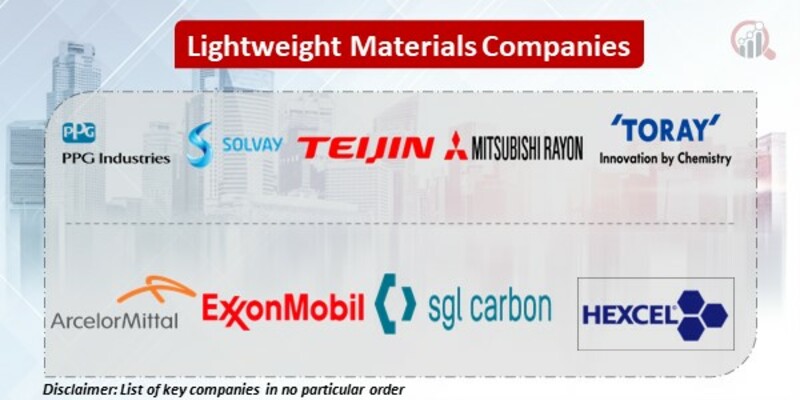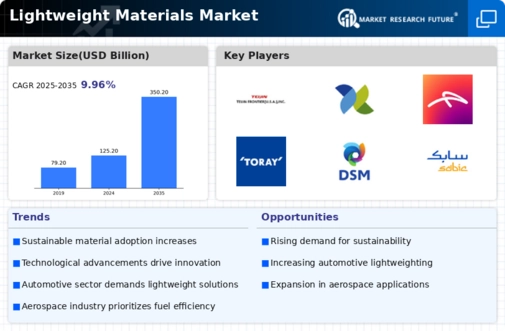Top Industry Leaders in the Lightweight Materials Market

Lightweight Materials Market
The lightweight materials market is soaring high, fueled by a relentless pursuit of efficiency and sustainability. This dynamic space, where strength meets lightness, is a battleground for established giants and nimble startups, all vying for dominance in a sky full of lucrative opportunities. To navigate this competitive landscape, we must understand the strategies, factors, news, and recent developments shaping its trajectory.
Strategies Adopted for Market Share:
-
Material Diversification: Players like ArcelorMittal and Novelis are expanding their portfolios beyond traditional aluminum and steel, venturing into advanced composites and magnesium alloys to cater to diverse industry needs. -
Sustainability Focus: The environmental imperative is driving innovation, with companies like SABIC and Covestro developing carbon-neutral and bio-based lightweight materials. Recycling and circular economy models are also gaining traction. -
Technological Innovation: Automation, digital manufacturing, and advanced design software are optimizing production processes and enabling lighter, stronger components. Companies like BMW and Boeing are heavily invested in R&D for next-generation lightweight materials. -
Vertical Integration: Some players are integrating backwards into raw material extraction or forwards into component manufacturing, gaining control over the value chain and improving cost efficiency. -
Strategic Partnerships and Acquisitions: Collaborations and acquisitions are commonplace, allowing companies to access new technologies, expertise, and markets. Examples include Ford's partnership with Dow for lightweight vehicle parts and BASF's acquisition of Austrian composite specialist, Conda Composites.
Key Players:
- Novelis Inc.
- PPG Industries Inc.
- Alcoa Corporation
- Arcelor Mittal S.A.
- Bayer A.G.
- China Hongqiao Group Limited
- Cytec Solvay Group
- Dead Sea Magnesium Ltd
- Exxon Mobil Corporation
- Owens Corning Corporation
- SGL Group
- Teijin Limited
- Toray Industries Inc.
- Formosa Plastic Corporation
- Hexcel Corporation
- LyondellBasell Industries N.V.
- Mitsubishi Rayon Co. Ltd
Recent Developments:
Jan 2022
Scientists are planting balsa trees in the tropical climate of China's Yunnan region to assist in strengthening the country's position as the world leader in wind generation. Balsa, a craft material for constructing model airplanes, is a key wind turbine with huge blades. China's $60 billion wind sector sources almost all of its components domestically, although it must import lightweight wood elsewhere. Suppliers are scrambling to locate enough balsa as the country that manufactures the most turbines in the world pushes to deploy wind power at a blazing speed to meet ambitious climate ambitions. China is now attempting to develop its own to alleviate the shortage and minimize imports.
Jan 2022 In a promising class of solar materials, researchers have reached record efficiency. According to the researchers, the novel materials such as ultrathin photovoltaics could be employed in applications ranging from wearable devices and sensors that are self-powered among other potential application. One of the most significant advantages of these transition metal dichalcogenides, can absorb high levels of sunlight that reach their surface. According to the report circulated in Nature Communications, the autonomous drones that can power themselves using a solar array on top its wing that is 15 times thinner than a piece of paper are being researched by doctorate students in electrical engineering at Stanford University.
February 2021: Boston Materials, an advanced lightweight materials manufacturer, has begun the shipping of its Z-axis carbon fiber manufactured using a 60-inch-wide roll-to-roll line to its consumers in Europe and North America. The demand for Z-axis lightweight carbon fiber has been escalating in industries like electronics, transportation, and industrial, and therefore, the company expects the setting up of its latest industrial-scale manufacturing line to foster its customer base. The first shipment will be the SUPERCOMP product, a high-performance lightweight 3D carbon fiber materials that boost energy dissipation, manufacturability and vibration damping of lightweight composite structures.

